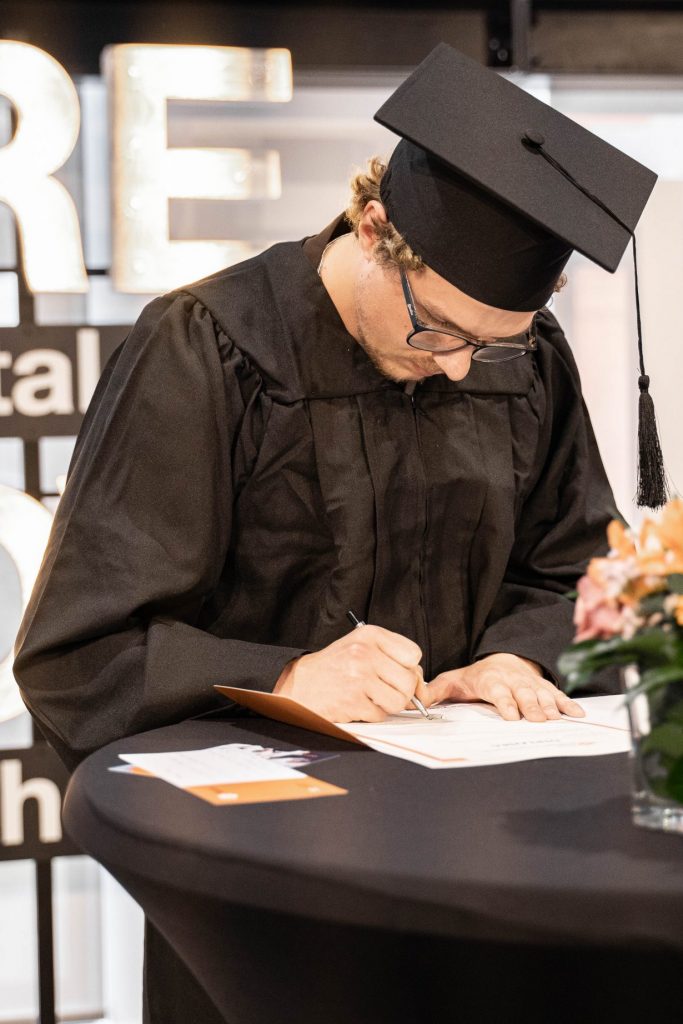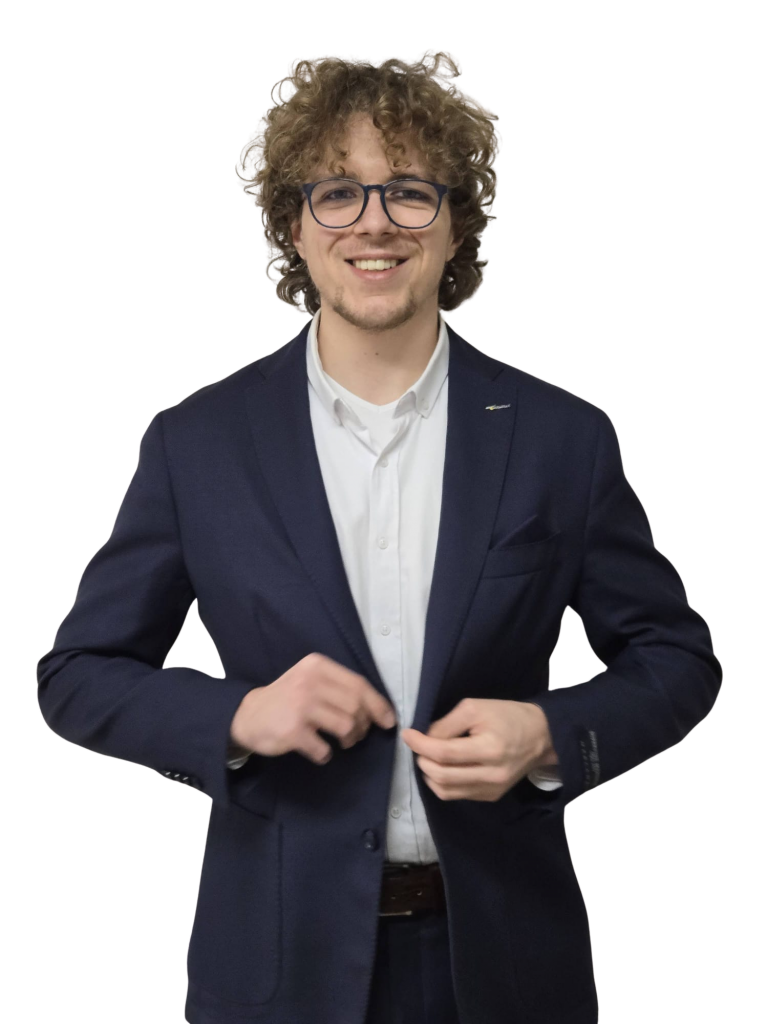Hi, I’m Tom Peters – communication & design are not just my profession, but my path.
From my first steps as a teenager in graphic design and video editing to studying International Communication in Groningen, I’ve been shaped by a passion for creativity, language, and people. Today, I combine creative ideas with clear strategy to make brands, projects, and stories visible.
This page tells my story: how video games turned into my first texture packs, how daily discipline and international experiences broadened my perspective – and how I learned to see communication and design not just as work, but as a mindset.
Already in my youth, my creative journey began. Through video games like Minecraft, I discovered my passion for digital design. Driven by the desire to make virtual worlds more beautiful and unique, I created my own texture packs, which to this day have reached over 32,000 downloads.
At the same time, I launched my first YouTube channel, where I discovered my enthusiasm for video editing and so-called film paraphrasing: storytelling through music, combined with condensed film sequences. My most successful project – a “Where is My Mind?” music edit with over 50,000 views and 800+ likes – became a key moment for me.
These early experiences in graphic design, storytelling, and editing laid the foundation for my current path with Tom Peters Communication & Design. Even though I wasn’t the classic illustrator, I found my expression through digital tools – and learned how visual design, music, and emotion can form a powerful language.
My professional journey began in a hands-on way: I started an apprenticeship as a Print Media Technologist at BZTG Oldenburg because I wanted to understand the foundations of communication and design not only in theory but also in practice – from paper and colors to printing processes.
However, a serious sports injury forced me to end the apprenticeship early. Instead of seeing this as a setback, I took it as an opportunity for a fresh start. With an exceptional digital portfolio showcasing my early work in design and video editing, I managed to convince the admissions team at BZTG’s design school.
The exam was a success: I was allowed to skip the 11th grade and enter directly into the 12th. This step not only marked the completion of my advanced technical diploma but also the transition from early creative projects to a clear, professional path in communication and design.
To finance my education and later my path to design school, I rolled up my sleeves early on. In the afternoons, I worked in the warehouse at DPD, loading containers and tackling physically demanding tasks as part of a team. On weekends, I took on additional shifts as a substitute at Deutsche Post, delivering mail throughout my region.
After a serious injury that left my leg shattered, I used these jobs not only to fund my education but also as a form of rehabilitation. The heavy lifting and loading at DPD strengthened my upper body, while the constant walking and carrying at Deutsche Post gradually helped restore strength and stability to my leg.
This period was physically challenging, but it taught me something that remains the foundation of my work today: discipline, clarity of purpose, and a strong work ethic. Even though it may seem far removed from Tom Peters Communication & Design, these experiences laid the groundwork for my mindset as a communication professional – perseverance, structure, and the ability to turn setbacks into strength.
After my time at BZTG Oldenburg, I already knew that my goal was to pursue a degree in International Communication. But before taking that path, I wanted to experience the world firsthand – through encounters, cultures, and direct exchange with people.
So I set out on a journey from Germany through Belgium, the Netherlands, England, Scotland, and Denmark, continuing on to the Czech Republic, Slovakia, Hungary, Serbia, Montenegro, Albania, and Greece. From there, I traveled further to Asia – visiting the Philippines, Korea, Nepal, and Japan. Each stop brought new impressions, new connections, and a deeper understanding of how differently communication and culture are lived around the world.
The COVID-19 pandemic abruptly cut short my originally planned route through the Americas and Africa. Yet this sudden stop only strengthened my determination to deepen my intercultural experiences not only through travel but also academically and professionally. Since then, I’ve continued exploring and have now surpassed visiting over 40 countries – though I still feel there’s much to catch up on, especially in the regions I couldn’t reach at that time.
These experiences were more than just adventures; they were a hands-on education in international and intercultural communication. They laid the foundation for my later specialization, which was recognized at university as my strongest skill set: international communication, inclusion and diversity promotion, and the ability to facilitate, translate, and bring together cultures.
After returning from my world trip, I began my studies in International Communication at Hanze University of Applied Sciences (UAS Hanze) in Groningen. The program focused on intercultural competence, international collaboration, and strategic communication – subjects that were already deeply rooted in me through my travel experiences. It quickly became clear that my practical background was an advantage: performance assessments especially highlighted my ability not only to understand inclusion, diversity, and cultural differences but also to actively facilitate and moderate them.
Alongside my studies, I took on responsibility in my home region. I became involved in local politics and was elected as the youngest councilor in my municipality. Soon after, I was appointed chair of a committee, which allowed me to apply my communication and organizational skills in a real political context.
The combination of academic training and practical responsibility shaped my path significantly: on one hand, I developed solid expertise in international communication; on the other, I learned how vital clear language, listening, and mediation are in political and societal processes. These experiences remain the foundation of my work in communication & design today – strategic, interculturally sensitive, and practice-oriented.
During my studies at UAS Hanze, I chose a minor semester in Brand Design and Psychology. This combination opened up a new perspective: not only designing brands visually and strategically but also understanding their psychological impact on people.
What fascinated me most was the field of neuropsychology, where I discovered my strongest aptitude. Under the guidance of Erik Schoppen, a recognized expert in brand and sales psychology, I deepened my knowledge of mass psychology as well as buying and selling processes. Here, I was able to excel not only theoretically but also with top performance, demonstrating how closely communication, design, and psychology are intertwined.
These experiences continue to shape my work today: every brand, every project, and every communication strategy are not just creative constructs but also psychological systems that influence behavior, perception, and decision-making. The connection between brand design and psychology remains one of my greatest levers when it comes to developing effective communication solutions.
Alongside my studies, I started establishing myself early on as a freelancer in marketing under the name Tom Peters Communication & Design. At first, it was a way to finance my academic journey, but it quickly grew into a portfolio of projects for businesses and private clients. This is where I learned not only how to design brands but also how to lead them strategically – from concept development and execution to long-term positioning.
In parallel, I gained over nine years of experience in the family real estate business, where I was responsible for branding, marketing campaigns, and public relations. This included traditional ads, PR articles, public outreach, and the creation of marketing materials. That work gave me deep insights into the link between communication strategy and business practice – and showed me the importance of tailoring brand messages precisely to their target audiences.
Today, I combine these experiences with my professional background in International Communication and Brand Design. The result is an approach that merges creativity, strategy, and psychological impact – delivering solutions that are not only aesthetically compelling but also measurably effective.
An important milestone in my professional development was my internship at the software company Orgadata, where I worked in the marketing department. There, I was able not only to deepen my programming knowledge but also to gain practical experience in PR, campaign planning, and internal communication.
A particularly exciting aspect was my involvement in the internal magazine, where I contributed to the branding and gained insights into editorial processes as well as visual implementation. At the same time, I learned how internal communication strategies are developed and executed to effectively reach employees and anchor brand values within the company.
This internship combined technical understanding, marketing, and design in a way that significantly shaped my later work. It showed me how important it is to plan communication strategically – both externally in PR and internally in corporate communication.

A particularly defining milestone in my academic career was my bachelor’s thesis in International Communication. For a Vietnamese company in the printing industry, with which I still collaborate today, I developed a comprehensive market entry strategy for the DACH region.
In doing so, I analyzed both the macro and micro conditions of the European market, identifying opportunities as well as regulatory challenges. A central focus was on the strict EU regulations regarding sustainable production, which are often crucial for Asian companies entering the market. My recommendation to switch to solar energy and obtain the relevant EU standards and certifications laid an important foundation for the ongoing expansion.
Interestingly, the strategy work not only led to a stronger focus on the European market but also to a growing presence of the company in Hong Kong. To this day, I continue to advise on its international expansion – a project that bridges theory and practice and demonstrates how communication, strategy, and market analysis work together.
An extraordinary milestone in my story was taking part in an Airbnb cultural project at the Colosseum in Rome. Out of more than 800,000 applications worldwide, I was selected along with only 16 participants. This was not just a coincidence, but also the result of strong PR and communication skills – abilities that were already shaping me at the time.
In the historic setting, I had the chance to take part in a gladiator fight together with my brother. This experience combined personal storytelling with international attention. Numerous media outlets picked up the story – in Germany, FOCUS reported on it, and the project was also covered in the U.S. and other countries.
For me, this moment symbolized what continues to drive me today: creating attention through powerful stories and reaching people on an emotional level. These are the very principles I now apply in my work in communication & design – where creative staging and strategic impact come together.


Today, I bring together my experience from Tom Peters Communication & Design and marketing with the values that have guided me from the very beginning: honesty, reliability, and creativity. For me, successful communication is not just about beautiful words or designs, but about clear messages that move people and strengthen brands.
Clients value my ability to combine strategic thinking with creative execution – always keeping in mind the psychological factors that influence attention, trust, and purchasing decisions. Whether in branding, public relations, or digital projects, my goal is to craft content that creates impact and delivers long-term value.
Looking ahead, I focus on intercultural competence, digital innovation, and sustainable communication. Because I am convinced: only those who look beyond the horizon can successfully lead brands into the future.
If you’d like to learn more or start a project together, feel free to get in touch with me.